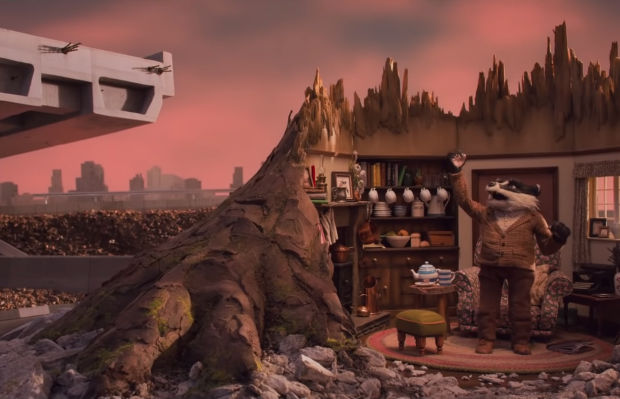
Wind in the Willows Takes a Dark Turn in Trailer Featuring David Attenborough

Sir David Attenborough, Stephen Fry, Catherine Tate, Alison Steadman and Asim Chaudhry are backing a new campaign for The Wildlife Trusts, calling for nature’s recovery in the UK. The new ‘Wind in the Willows: Official Trailer’ brings to life the 21st century threats facing the much-loved characters from the children’s classic. The animation calls on everyone to help bring our wildlife back and secure a wilder future, before it’s too late.
Created by advertising agency Don’t Panic and produced by animation house ROWDY, the film trailer shows how the lives of Badger, Ratty, Mole and Toad have been disrupted by bulldozers, pollution and intensive agriculture. Their homes have been destroyed and broken up and the wild landscape they need to flourish within, is now a hostile and poisoned place.
Rick Dodds, creative director, Don’t Panic said “In recent years, Hollywood has done a great job of adapting our classic children’s book stories for the big screen. So we chose the most British of them all, and enlisted the help of Badger and friends to highlight the stark reality of the British countryside. The narrative arc of the film trailer closely echoes the story of our countryside. In the beginning it was beautiful and plentiful, then things get pretty dark and twisted - but at the end there's hope because there's still time to do something about it.”
Ellie Moore, head of engagement, Don’t Panic said “Our campaign strategy focused on creating a strong sense of nostalgia; making the problem relatable to supporters of all ages. By using a trailer mechanic we’re also able to distribute key content in familiar formats, making people look twice and creating a value exchange through the reveal. The launch film will be promoted primarily through social to optimise for peer engagement, supported by a one-week cinema run on screens across the UK, as donated by DCM. We’ll then employ a retargeting strategy to usher new supporters through our user journey and encourage them to take personal actions to save our wildlife throughout Spring.”
The characters and scenes were created by ROWDY, part of the team behind Wes Anderson’s Isle of Dogs. Shot over 23 consecutive days shooting at Clapham Road Studios, the trailer uses stop-frame animation and shot on a Canon D5 MK III with Zeiss master prime lenses. The animators focused on the correct genus of the species and were influenced by the original illustrations.
Thomas O’Meara, director, ROWDY: “We’re really happy to have made this film for The Wildlife Trusts because we think it’s such a brilliant idea: taking the classic story of Wind in the Willows and subverting the narrative half-way through to show the destruction and devastation that’s being caused to UK habitats and wildlife that lives there in 21st century UK.”
Matthew Day, director, ROWDY said “I’d been reading Wind in the Willows to my son when we got the call – it seemed like a happy coincidence. People connect to this children’s story, but however much everyone says they love the countryside, they don’t think about it needing protection and that we how proactive we need to be to ensure it remains the same.”
Sound design and music company String and Tins were brought on board to supervise the whole soundtrack, including composing an original piece of music, creating the sound design and recording all dialogue for the spot.
Composer and Sound Designer, Will Cohen, comments: “My first thought when we found out about the project was to speak to the original composers to discuss re-working the 1983 theme. That introduction is so incredible, with this beautiful soaring cello - but it has a melancholy that wasn't going to work for our first section. The directors and I share a love of the work of Elgar and Vaughan Williams - we shared some tracks and then I hid away in my studio, tried to forget all the specific melodies in the references and wrote something new. It's impossible to create totally original work; I guess we're all made of our influences, but in this film it's about using those tonal memories to our advantage and then breaking the spell in the middle sequence.
The music was performed mainly by live instruments with some supporting synth work in the middle of the piece - Will worked with distinguished orchestrator Simon Whiteside, lead violinist Dorry Macaulay, and the Fames Project Orchestra to create the work.
Will defines five clear shifts in mood during the film: “Ideas behind the five cues in the film are, 01: nostalgic theme 02: energetic rock 03: dark designed desolation 04: melancholic cello 05: growing positivity with a reflection of the first theme.”
“It was important for us to get the right energy in cue 02 in order to kill it and create this brooding dissonance. For the intro the references were British composers of the 1900s, the middle was more contemporary obviously. The second cue was a bone of contention - we thought it might need to be more fun pop at one point. Lawrence and I cut a few rock tracks from our String and Tins catalogue and a composition by the most excellent Andy Stewart popped out to me - ridiculously and unashamedly fast and silly - perfect for toad! With my sound designer hat on, I kinda knew that third cue would be made up of a blend of simple swelling, drawn out clashing notes, with synthetic layers and ambience blended together to create this really uncomfortable place. So stripped back, the real music at that point is just a bass clarinet, trombone and two french horns - but I built on that and blended those with synths and re-sampled machine loops to create the drone that seeps in and out. The final cue was tricky as we wanted it to be upbeat but subtle, similar to the first cue but higher tempo.”
Kenneth Grahame wrote The Wind in the Willows just over a hundred years ago. In the last fifty years alone, we know that over half of our species have declined - mainly due to climate change and habitat loss/degradation from farming or inappropriate development. Badger, Ratty, Mole and Toad are being disrupted by bulldozers, pollution and intensive agriculture. Their homes are being destroyed and broken up – and the wild landscape they need is a hostile and poisoned place. These losses have led to the UK becoming one of the most nature-depleted countries in the world.
Stephanie Hilborne, CEO, The Wildlife Trusts said “We are a nation of nature-lovers, yet we live in one of the most nature-depleted countries in the world. If we want to put nature into recovery we have to create a mass movement of people calling for change. Our film is a sad version of The Wind in the Willows – showing how Ratty and Toad have hit the buffers – but it ends with a message of real hope. It’s not too late to create strong laws which will help our wildlife make a comeback – and it’s not too late to establish a Nature Recovery Network which will enable us to plan a wilder future.”
Sir David Attenborough, president emeritus of The Wildlife Trusts, says: “I am backing The Wildlife Trusts’ campaign to rally people to secure a “wilder future” by restoring large areas of wildlife habitat, in city and country. What we create may not look exactly like the countryside that Kenneth Grahame drew such inspiration from, but our wildlife won’t mind just so long as it has the places it needs to live and thrive.
As a society we know how to put meanders back into straightened rivers and how to build bridges for wildlife. We know which wild places we should be protecting and expanding. But we need ambitious new laws to ensure we do this, laws that ensure we map out nature’s recovery.
Meanwhile we can all make a practical difference. If you have a window sill or balcony you can put up bird feeders or plant pots of wildflowers. If you have a garden it is easy to dig a small pond or make holes in your fence for hedgehogs to wander through. It is not too difficult to take up paving slabs to let plants grow to feed our bees.
Together we can make the next chapter for wildlife a happier one. Join us to put nature into recovery.”
The Wildlife Trusts hope The Wind in the Willows film trailer will inspire people to help by nature by:
● Contacting politicians – to call for strong environmental laws which help nature recover
● Walking in the pawprints of others – and imagine what wildlife needs to survive in your neighbourhood. Be inspired to take-action for wildlife in your garden or local area, working with friends, neighbours – or by getting your local council involved – to create new homes for Toad, Ratty, Badger and friends.
● Creating a Wilder Future where you live – by checking out the latest events and volunteering opportunities at local Wildlife Trusts to discover what a Wilder Future could look like – and the part everyone can play in making it happen.
Stephen Fry, president of the Great Fen, Wildlife Trust Bedfordshire, Cambridgeshire and Northamptonshire, who plays Badger, says: “I’ve acted in and narrated Wind in the Willows in the past but this version is different – it really, really matters. I adore what’s left of Britain’s wild and precious places and I’m a passionate supporter of my local Wildlife Trust which is restoring a huge part of the fens for nature. We all need to get behind The Wildlife Trusts, rise up and call for a wilder future – otherwise it’ll be too late to save Toad, Ratty and all the residents of the riverbank and beyond.”
The trailer will be released on social and www.wildlifetrusts.org from Thursday 28th March and will be played for two weeks in 500 cinemas across the UK from Friday 29th March.













